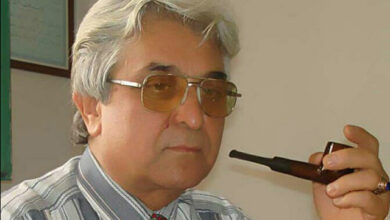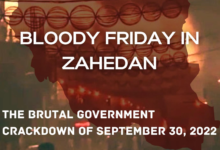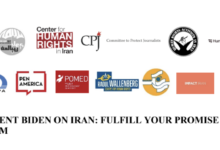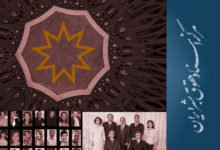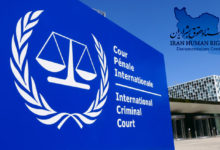The terror of Tehran
LUIZA CH. SAVAGE | Oct 24, 2006
Houshang Bouzari, a former Iranian civil servant and businessman who now lives outside Toronto, spent eight months in Tehran’s prisons starting in June 1993. He was beaten until his kidneys failed, put through two mock hangings, and forced to eat human waste. “I tried to kill myself,” he recalls. “I hit my head against the wall, but there is not enough room in a four-by-six-foot solitary confinement cell to run and hit the concrete hard enough to give yourself a concussion.” After his release, he encountered one of his tormentors. “Of all the people you met while you were our guest,” the man taunted, “which had a softer hand?” Bouzari said he had no idea, since he had been blindfolded. “I claim mine was softer,” replied the youthful-looking man with glasses. Bouzari recognized him as one of the most feared men in Iran: Saeed Mortazavi, now the public prosecutor of Tehran.
Only 38 years old, Mortazavi has a reputation worthy of his Dickensian name. In Iran’s revolutionary legal system, he acts as interrogator, prosecutor, judge and jury. He has orchestrated the mass incarcerations of human rights activists, journalists, political dissidents and students. His specialty is forced confessions. A 2004 report by Human Rights Watch declared, “Few individuals bear more responsibility for turning the judiciary into a tool of the ongoing political crackdown than Saeed Mortazavi.” His victims cannot seek redress because Mortazavi is their judiciary. “I don’t have any need for the law,” he once told a prisoner’s family, according to the report. “I am the law.” But that day in June 2003, when he added Montreal photojournalist Zahra Kazemi to his roster of victims, he created a rare opening for accountability — if the Harper government, unlike its predecessors, makes good on its threats to seize it.
Unlike Bouzari, Kazemi, an Iranian-Canadian who spent time as Mortazavi’s “guest” in 2003, didn’t live to tell about it. After Mortazavi had her arrested for taking pictures of a vigil outside Evin prison, she endured three days of interrogations, some of which were personally overseen by Mortazavi himself. She emerged from prison with massive bruises, a broken nose, broken fingers, crushed toes and nails, pelvic damage indicative of a “very brutal rape,” a fractured skull, and brain injuries from which she eventually died. But Mortazavi is now fair game: our Criminal Code gives Canadian courts jurisdiction to prosecute torturers even if the torture occurred outside Canada. And countries that have ratified the UN Convention Against Torture are required to either prosecute suspected torturers on their soil, or extradite them. If Canada can build a case against Mortazavi, it can request he be arrested and extradited. Assuming Iran refuses, Mortazavi will have to stay at home, or run the risk of immediate arrest if he leaves the country.
This past June, the Harper government talked tough about moving against Mortazavi. Foreign Minister Peter MacKay had arrived in Geneva for a meeting of the newly formed United Nations Human Rights Council. To the disgust of many participants, Mortazavi was in attendance. Tipped off that the Iranian would travel home through Frankfurt, and pressured by Iranian expats, Prime Minister Stephen Harper and MacKay announced that they had asked German authorities to arrest him. Harper went so far as to say he wanted Mortazavi tried for “war crimes.”
Such legal manoeuvrings require extensive preparations, though, and Ottawa was nowhere near ready to make good on the threats. Complicating matters was the fact that Mortazavi did not travel through Germany; he went straight to and from Switzerland. But also, as MacKay’s office later admitted, the government had not laid the legal groundwork needed for an extradition request. A Harper spokesman was left to backpedal, saying the PM had spoken “loosely.” And MacKay was left shaking a rhetorical fist. “Mark my words, this individual is on notice. If there is any way Canada can bring this person to justice, we’ll do it.”
Months have passed, and so far the threats have amounted to little more than talk. John Terry, the lawyer for Kazemi’s son, Stephan Hashemi, says he has been given no confirmation as to whether the government has asked the RCMP to gather the evidence that could lay the basis for any charges against Mortazavi. Admittedly, it’s not an easy task: Iran refused to release Kazemi’s body. But if anyone in Canada has the tools to begin this process, it’s the RCMP, Terry says. In July, Hashemi filed a civil suit in Quebec against Mortazavi and other officials, seeking $17 million in damages. But Hashemi and Terry don’t have the investigative tools to get to the bottom of Mortazavi’s role in Kazemi’s death. “There are things the RCMP can do in terms of witness protection that I as a lawyer in Toronto can’t offer,” Terry notes.
He says officials have told him they would normally not build a case unless Mortazavi is likely to travel to countries from which he could be extradited. “If authorities believed there was a reasonable prospect he could be brought to Canada through extradition, then they’ve advised us they would be more likely to take steps to commence an investigation,” Terry says. “They would be less likely if there is not a chance he can be brought here.”(A Justice Department spokesman would only say that a criminal investigation is needed before an extradition request could be made. He could not comment on whether one was planned or underway.)
But waiting until his capture becomes a “reasonable prospect” means that, if Mortazavi were again to travel suddenly, Canada would again be caught unprepared. For this reason, there is a precedent for laying the groundwork for seizing suspected international criminals, even if the prospect of apprehension is remote. Slobodan Milosevic, for example, was still president of Yugoslavia when he was indicted in 1999 on war crimes charges by an international tribunal.
Harper’s parliamentary secretary Jason Kenney, who is active on the issue of human rights in Iran, says the government is still looking at what to do. “I think the steps taken by Peter MacKay in the summer were courageous and the right thing to do. We continue to examine our options.” But as they do so, it’s unclear what advice MacKay and Harper are getting from federal lawyers. The secretary-general of Amnesty International Canada, Alex Neve, doubts it’s a display of enthusiasm. There is long-standing confusion within the government about what Canada should do in charging individuals for serious human rights violations when they are not in the country, he said. “There has been serious resistance in the past, and government lawyers have consistently advised past governments that the reach of Canadian law does not go beyond our borders,” Neve says.
But while government lawyers are concerned with the practicalities of bringing charges, much less winning a case, human rights advocates see a legal move against Mortazavi as much more than a quest for justice for one Canadian. It would be a strategic foreign policy decision, they say, with a twofold aim: discouraging torture, and undermining Iran’s repressive regime. Even if Mortazavi never again sets foot outside Iran, the mere threat of arrest, the argument goes, could affect the regime, as the increased international scrutiny might help weaken its grip on power.
“We have the precedent of Yugoslavia, where people still in power were indicted — and they lost legitimacy, because who wants to invest political capital in someone who is wanted,” says Payam Akhavan, a former adviser to the UN war crimes prosecution at The Hague and professor of law at McGill University. Pressure on Mortazavi might also result in the regime easing up on methods such as his. “Cases like this operate at both levels,” Neve says. “Individual justice is critical for the victim, their family, and the alleged perpetrator, but that fits into a wider context of the crucial long-standing need to shatter the impunity that has always stood behind this planet’s most horrific human rights violations.”
If Harper and MacKay are serious in their intentions, they may have to impose their will on the bureaucracy, Neve adds. “This is a situation where you want, and should be taking account of, solid legal advice, but ultimately some political leadership will be necessary to do the right thing,” he says, noting that Canada has long taken the lead in international forums in pressing for international justice. “It is critical for us as a nation to pursue actions that back up our words.”
But others are skeptical. Hamid Mojtahedi, a Toronto human rights lawyer who has met Mortazavi, calls any efforts to bring him to justice “a waste of everyone’s time” that will be dismissed in Iran. “I think it’s a waste of resources — I don’t think it’s going to be effective,” Mojtahedi says. “It will show the world we don’t approve of the regime, but I think we’ve already done that.”
In the meantime, the public prosecutor soldiers on, unbowed and unrepentant. Mojtahedi met Mortazavi while serving as a representative of Lawyers Without Borders during the Kazemi affair. He recalls being received in an ornamental but high-tech office, with Mortazavi holding a stack of transcripts of media interviews in which Mojtahedi claimed Kazemi, 54, had been raped(the accusation was later confirmed by a military doctor who examined her). Mortazavi served an elaborate lunch, while repeatedly demanding to know who had leaked the allegations. Mojtahedi also says Mortazavi asked him, “Have you ever met Kazemi? A woman of her physical appearance and age, is she even worthy of rape?” Mortazavi was amicable but temperamental, Mojtahedi says. “He said he had the stamp of approval of the supreme leader and is untouchable.”
Mortazavi earned the backing of that supreme leader, Ayatollah Ali Khamenei, through ruthless loyalty. “He is a nobody who became somebody because he proved to be cruel enough to do anything,” says Bouzari, who got Canadian citizenship in 2001. Mortazavi began his career as a 22-year-old legal functionary in Iran’s central region of Yazd, a desert area known for its mud architecture and Zoroastrian temples. Within five years he was appointed head of the chief of judiciary of Kerman province, according to Hadi Ghaemi, Human Rights Watch’s Iran researcher.
Two years later, barely 30 years old, he became the judge of Tehran court No. 1410, known as “the press court,” where he earned the title “Butcher of the Press.” Mortazavi dusted off an obscure 1950s statute originally written to prevent criminal street gangs from intimidating shopkeepers and passersby, and used it to persecute journalists. An estimated 100 newspapers and journals were closed, and their staff imprisoned. “I have talked to former prisoners who were directly threatened by him, and whose interrogators said they were carrying orders from Mortazavi,” Ghaemi says. “I have people who have been forced into making false confessions through lengthy intimidation, threats, and physical abuse by his underlings.”
According to a Human Rights Watch report, Iranian authorities “began funnelling sensitive cases to his court, secure in the knowledge that they would end in a conviction, regardless of the quality of the evidence against the accused.” Witnesses have alleged that, while on the bench, Mortazavi would openly confer by phone with government officials about how to handle individual cases. In 2002, he ordered the arrests of three Iranian pollsters for spying, after they conducted a poll showing that 74 per cent of Iranians favoured re-establishing ties with the U.S. In May 2003, he was appointed the public prosecutor in Tehran, just a month before Kazemi’s arrest. In the fall of 2004, Mortazavi imprisoned some 20 Iranian bloggers, and broadcast their forced confessions on TV. They later told a presidential commission that they endured physical and psychological torture. The tactics work. “The press prepares its front page based on Judge Mortazavi’s orders, because they are scared of closure,” Iranian member of parliament Mohsen Armin wrote in July 2003.
Mortazavi’s involvement in Kazemi’s case fits the pattern. The New Haven, Conn.-based Iran Human Rights Documentation Center recently released a detailed report on the available evidence, including translations of original documents. Kazemi was brought into Evin at 5:40 p.m. on June 23, 2003, and between 10:25 that night and 2:30 a.m., she was interrogated by Mortazavi and a deputy. Prison records show that during her encounter with Mortazavi’s crew, she was beaten and her nose and her fingers and toes were broken and crushed.
After the interrogations, Mortazavi issued a warrant for her arrest on charges of espionage. Mojtahedi says Mortazavi put it to him this way: “He said, ‘every game has its rules and this lady did not play by the rules.’ By this he meant she was confrontational, she questioned his authority.” As Kazemi continued to vomit and faint, at times being literally dragged between prison cells, Mortazavi sent her for more interrogation by various ministries rather than provide medical treatment. As a result of her injuries, Kazemi lapsed into a coma on June 27, and her life support was removed 13 days later.
Mortazavi’s actions have been investigated by a presidential commission, launched within days of Kazemi’s death by then-reformist president Mohammad Khatami. It concluded Kazemi was killed by a blow to the skull, and it also recommended more investigation(the case was initially assigned to Mortazavi, who relinquished it only under pressure). A subsequent Iranian parliamentary investigation published its findings in October 2003 but was all but ignored. It called Mortazavi’s decision to arrest Kazemi “peculiar” and “not permissible” since there was no evidence she had committed a crime, and the intelligence ministry did not consider her a spy. The parliamentary commission also found that Mortazavi tried to cover up what happened by ordering a prison official to write a letter stating that Kazemi had suffered a stroke. As well, the commission found forgeries and erased signatures on the prison log — and it also reprimanded Mortazavi for trying to derail the investigation.
In fact, a newspaper editor later came forward to say Mortazavi personally ordered him and others not to cover the commission’s report. An official in the press ministry who issued Kazemi’s work permit, Mohammed Hossein Khoshvaght, told the commission that Mortazavi threatened him with imprisonment if he did not put out a press release stating that Kazemi died of a stroke. When the trial of a low-level intelligence official for the “semi-intentional killing” of Kazemi got underway(he was eventually acquitted), Mortazavi ordered the closures of two newspapers that reported on the proceedings.
Three years later, not only is Mortazavi getting away with it all, but under the conservative presidency of Mahmoud Ahmadinejad, the prosecutor’s hand has only strengthened. In August, the government asked Mortazavi to clamp down on the press after newspaper editorials accused Ahmadinejad of financial wrongdoing. And the judiciary was reportedly given a newly created force of 800 “judicial police” to enforce orders. Dan Dugas, a spokesman for MacKay, says it remains the Harper government’s position to go after Mortazavi. “We would like him to answer for allegations of his involvement in the brutal rape and murder. We would take every opportunity to do so.” But if June’s failed attempt is any indication, Ottawa’s opportunities will be those it decides to create.
http://www.macleans.ca/world/global/article.jsp?content=20061030_135293_135293




